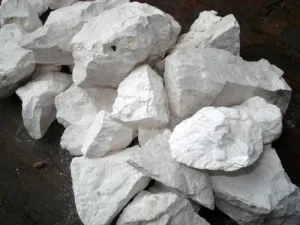A Key Ingredient for Sustainable Building
Introduction to Lime Mineral in Construction
Lime, a calcium-containing mineral derived from limestone, has been used in construction for centuries. Today, it remains a vital material in modern building practices due to its versatile properties, affordability, and environmental benefits. Whether in the form of quicklime (calcium oxide) or slaked lime (calcium hydroxide), lime plays a key role in sustainable construction, providing strength, durability, and environmental advantages for a wide range of applications.

The Role of Lime in Construction Materials
Lime is a fundamental component in various construction materials, including mortar, plaster, and cement. Its unique chemical properties make it an essential element in construction for several reasons:
- Binder in Mortar and Plaster: Lime acts as a binding agent, giving mortar and plaster their adhesive strength. It enhances the durability of structures by creating a flexible yet strong bond, allowing buildings to withstand environmental changes like moisture and temperature variations.
- Stabilizing Soil in Foundations: Lime is frequently used in soil stabilization, a process that enhances the load-bearing capacity of foundations. Adding lime to soil improves its strength and resistance to swelling, making it ideal for road construction and the foundations of large buildings.
- Key Ingredient in Cement: Lime is an integral component of Portland cement, the most widely used type of cement. It reacts with other materials during the cement-making process to form compounds that give cement its binding properties, making it critical for producing durable concrete structures.
https://iranmineral.net/the-best-way-to-cut-sandstone/
Environmental Benefits of Lime in Construction
Lime mineral is not only useful in construction but also offers significant environmental advantages, making it a more sustainable option compared to other building materials:
- Carbon Capture: Lime has the natural ability to absorb carbon dioxide from the atmosphere during the curing process, known as carbonation. This property makes lime-based materials environmentally friendly, as they help reduce the overall carbon footprint of construction projects.
- Energy Efficiency in Production: Compared to cement production, which requires extremely high temperatures, lime is produced at lower temperatures, resulting in lower energy consumption and reduced CO2 emissions. This makes lime an eco-friendly alternative for industries looking to minimize their environmental impact.
- Recyclability: Lime-based materials are easily recyclable, further enhancing their sustainability. Lime mortar, for example, can be reclaimed and reused, helping to reduce waste in construction projects and promoting circular building practices.
https://iranmineral.net/lime-mineral-in-soil-ph-management/
Applications of Lime in Modern Construction
Lime’s versatile properties make it useful in a wide range of modern construction applications:
- Restoration of Historic Buildings: Lime mortar is widely used in the restoration of heritage and historic buildings due to its compatibility with traditional building materials. Unlike modern cement, lime allows structures to “breathe,” reducing the risk of trapped moisture that can damage walls over time.
- Eco-Friendly Homes: Lime is a popular choice in eco-construction, such as building earth-friendly homes. Lime plaster, limewash, and limecrete are natural alternatives that provide thermal insulation and moisture regulation, contributing to energy-efficient and healthy indoor environments.
- Waterproofing and Damp Control: Lime is naturally breathable and helps regulate moisture. When used in building foundations or as a plaster, it can prevent water ingress and reduce dampness in structures, making it an effective choice for regions with high humidity or water exposure.
The Incredible Benefits of Gypsum
Challenges and Solutions in Using Lime for Construction
While lime offers numerous benefits, there are some challenges associated with its use in construction. However, these challenges can be mitigated with proper techniques and knowledge:
- Longer Setting Time: One of the drawbacks of lime is its slower curing process compared to modern cement. However, advancements in lime technology and blends, such as hydraulic lime, offer faster setting times while retaining lime’s beneficial properties.
- Special Handling and Application: Lime requires specialized handling and techniques, especially when used in restoration work. Construction teams need to be trained in lime application to ensure optimal results and longevity of the structure.
- Cost Considerations: While lime is generally affordable, certain high-quality lime products or applications, such as historic building restoration, can be costlier. However, the long-term benefits of durability, sustainability, and low maintenance costs often outweigh the initial investment.

